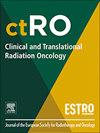超中央肺肿瘤立体定向放疗中如何保护近端支气管树:磁共振引导治疗的经验。
IF 2.7
3区 医学
Q3 ONCOLOGY
引用次数: 0
摘要
目的:利用超中心性肺肿瘤(ULT)立体定向磁共振引导在线自适应放疗(SMART)的影像学数据,为ULT立体定向全身放疗(SBRT)的安全非自适应入路发展提供参考。患者和方法:分析基于前瞻性MAGELLAN试验中19例接受SMART (10 × 5.0-5.5 Gy)治疗0.35 T MR-Linac (MRIdian®)的ULT患者。6例患者的4d规划CT数据用于量化近端支气管树(PBT)呼吸运动。每日分数mri用于计算分数间平移(中外侧(ML),前后(AP),上-下(SI))及其对PBT的剂量学影响。在深度吸气屏气(DIBH)和表面引导(AlignRT®)中,计算了假设的非自适应SBRT的规划风险量(PRV)。最后,对N = 10例患者(10 × 5.5 Gy)的非自适应体积调制电弧(VMAT) SBRT进行了有和没有PRV的模拟。结果:PBT显示相应的呼吸运动,尤其是上下方向(中位ML: 2.5 mm, AP: 1.9 mm, SI: 9.2 mm)。此外,观察到适度的分数间平移(平均绝对平移ML: 1.3 mm, AP: 1.3 mm, SI: 1.1 mm),仅分数间变化的PRV边缘估计为2mm。模拟非适应性SBRT导致60%的患者PBT过量(过量剂量中位数VMAT: 2.5,预测MR-linac计划4)。mr引导的在线计划适应(SMART)和基于prv的非适应性VMAT均可预防PBT过量,但SMART的计划目标体积(PTV)覆盖率显著更高(SMART:中位数96% [IQR 95-96], VMAT:中位数89% [IQR 77-94], p = 0.014)。结论:在ULT的SBRT过程中,术中呼吸运动和术中平移都可能影响PBT的剂量。SMART保护PBT免受过量使用,同时保持高PTV覆盖率。采用先进的呼吸运动管理和PRV,非自适应SBRT似乎是安全的,但PTV覆盖率较低。本文章由计算机程序翻译,如有差异,请以英文原文为准。
How to protect the proximal bronchial tree during stereotactic radiotherapy of ultracentral lung tumors: Lessons from MR-guided treatment
Purpose
To use imaging data from stereotactic MR-guided online adaptive radiotherapy (SMART) of ultracentral lung tumors (ULT) for development of a safe non-adaptive approach towards stereotactic body radiotherapy (SBRT) of ULT.
Patients and Methods
Analysis is based on 19 patients with ULT who received SMART (10 × 5.0–5.5 Gy) on a 0.35 T MR-Linac (MRIdian®) in the prospective MAGELLAN trial. 4D-planning CT data of six patients served to quantify proximal bronchial tree (PBT) breathing motion. Daily fraction MRIs are used to calculate interfractional translations (mediolateral (ML), anterior-posterior (AP), superior-inferior (SI)) and their dosimetric consequences for the PBT. A planning risk volume (PRV) is calculated for an assumed non-adaptive SBRT in deep-inspiration breath hold (DIBH) with surface-guidance (AlignRT®). Finally, non-adaptive volumetric modulated arc (VMAT) SBRT is simulated with and without a PRV for N = 10 patients (10 × 5.5 Gy).
Results
The PBT shows relevant breathing motion, especially in superior-inferior direction (median ML: 2.5 mm, AP: 1.9 mm and SI: 9.2 mm). Furthermore, moderate interfractional translations are observed (mean absolute translation ML: 1.3 mm, AP: 1.3 mm, SI: 1.1 mm), with an estimated 2 mm PRV margin for interfractional changes alone. Simulated non-adaptive SBRT leads to PBT overdoses in 60 % of patients (median overdosed fractions VMAT: 2.5, predicted MR-linac plans 4). Both MR-guided online plan adaptation (SMART) and PRV-based non-adaptive VMAT prevent PBT overdoses, but SMART yields significantly higher planning target volume (PTV) coverage (SMART: median 96 % [IQR 95–96], VMAT: median 89 % [IQR 77–94], p = 0.014).
Conclusions
Both intrafractional breathing motion and interfractional translations may impact doses to the PBT during SBRT of ULT. SMART protects the PBT from overdoses while maintaining high PTV coverage. Non-adaptive SBRT appears safe with advanced breathing motion management and PRV, but yields inferior PTV coverage.
求助全文
通过发布文献求助,成功后即可免费获取论文全文。
去求助
来源期刊

Clinical and Translational Radiation Oncology
Medicine-Radiology, Nuclear Medicine and Imaging
CiteScore
5.30
自引率
3.20%
发文量
114
审稿时长
40 days
 求助内容:
求助内容: 应助结果提醒方式:
应助结果提醒方式:


